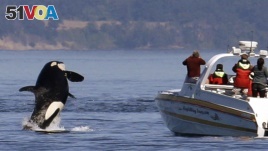04 May, 2019
The endangered killer whales of the Pacific Ocean have very different lives from orcas in captivity.
These wild animals live along the coast of western North America, in an area called the Pacific Northwest.
The wild orca swim up to 160 kilometers a day looking for fish like salmon. People sailing on Washington state ferries and small boats enjoy watching the whales' playful splashing. The animals appear to jump out of the ocean for brief periods, and strike the water with their tails and fins.

An orca leaps out of the water near a whale watching boat in the Salish Sea in the San Juan Islands, Wash.
In comparison, the captive whales are fed a diet of small fish and vitamins. People pay to see them put on a show at SeaWorld theme parks in the United States.
But the captive whales are helping researchers trying to save the wild whales in the Pacific Northwest.
Information from 20 years of tests
SeaWorld keeps orcas at its parks in California, Texas and Florida. Recently, SeaWorld published information from thousands of routine blood tests of its killer whales. The tests were taken over the past 20 years. They provide the best picture yet of what a healthy whale looks like. The information could help scientists understand when they should act to help sick or stranded whales in the wild.
Deborah Fauquier is a medical officer at the National Marine Fisheries Service. She specializes in caring for animals.
Fauqier says the information from theme parks is very useful because it is almost impossible to get blood from wild orcas.
"For us, collecting blood from free-ranging killer whales is exceedingly difficult, so it's something we would rarely ever do," she said.
In the 1960s and 1970s, crews captured wild orcas for display at SeaWorld's theme parks. The move was terrible for the Pacific Northwest's native whale population.
The Center for Whale Research on Washington's San Juan Island reports that at least 13 whales were killed. Forty-five others survived and were kept to entertain paying crowds around the world. Today only one of those orcas is alive: Lolita, at the Miami Seaquarium.
Washington's state government took SeaWorld to court to stop the whale hunts. Today, 17 of SeaWorld's 20 orcas were born in captivity. Some came from animals captured near Iceland.
SeaWorld has not captured a wild orca in more than 40 years. Public pressure made the business end its captive breeding program in 2016. Now instead of trained orca shows, it has "more educational experiences where guests can still enjoy and marvel at the majesty and power of the whales."
It took years for wild orcas in the Northwest to recover from the hunts. These creatures have a name: southern resident killer whales. They spend several months every summer and autumn in the ocean waters between Washington and Canada. By the middle of the 1990s, their population reached 98.
New threats
Today, the orcas are struggling against different threats. Those problems include ocean pollution, ship noise and, most seriously, starvation from a lack of Chinook salmon, their favorite food. There are just 75 left, and researchers say they are almost extinct.
Washington's governor, Jay Inslee, has proposed spending $1.1 billion to help the whales. Much of the money would go toward protecting and restoring the areas where salmon live.
The National Marine Fisheries Service, also known as NOAA Fisheries, wants to expand the protected areas where the whales eat.
SeaWorld has increased its efforts to help the southern resident orcas. It also has promised to give $10 million to the National Fish and Wildlife Foundation's Killer Whale Research and Conservation Program.
Todd Robeck is SeaWorld's vice president of conservation research. He told the Associated Press: "Our stance is to do research with our animals to try to help this population now, and that's what we're doing. That's why I got into what I do — to try to help animals in the wild."
Blood tests for Orcas
Robeck helped prepare a report on SeaWorld's data, which included results of more than 2,800 blood tests on 32 whales from 1993 to 2013. The whales were trained to hold up the underside of their tails for the blood draws, which were taken once or twice a month. A number of blood values were measured.
The results show that most of the values are not very different between male and female whales, but they do differ with age and season, Robeck said. The study suggests that orcas lose some ability to fight infection and disease as they age.
"It's something that could only be done with our animals," Robeck said. "It's an example of how we are dedicated to participating in the well-being of killer whales in the Pacific Northwest and around the world, and how research with our animals is vital in answering some of these questions about how to address the needs of the animals in the wild."
I'm Jill Robbins.
Gene Johnson reported on this story for the Associated Press. Jill Robbins adapted it for Learning English. George Grow was the editor.
_______________________________________________________________
Words in This Story
tail – n. the back end or bottom of an animal
fin – n. a flatted body part of a fish or sea creature
theme park – n. an area with a central, unifying idea or setting
stranded - adj. to cause something to become stuck or trapped on land — usually used as (be) stranded
entertain – v. to provide enjoyment; to interest or please
majesty - n. a great and beautiful quality
extinct - adj. no longer existing
restore – v. to bring back; to return to a former condition
stance - n. a publicly stated opinion
draw - n. to get something from something else
Do you enjoy watching whales? What do you do to help clean up the oceans? Write to us in the Comments Section.